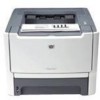HP P2015 HP LaserJet P2015 - Software Technical Reference - Page 207
Available PostScript Memory, Output Protocol, Send Ctrl-D Before Each Job, Print Info s, Print - reset
 |
UPC - 882780491984
View all HP P2015 manuals
Add to My Manuals
Save this manual to your list of manuals |
Page 207 highlights
● Minimum Font Size to Download as Outline ● Maximum Font Size to Download as Outline Available PostScript Memory This control specifies the amount of available postscript memory and provides a spin box for changing this value. The available postscript memory is a subset of the device total physical memory. It is usually best to set the postscript memory to match the total RAM that is shown on the configuration page. To print a configuration page, open HP ToolboxFX, select Print Info Pages, and then click Print next to the Configuration page option. Output Protocol This control specifies the protocol that the device uses for print jobs. The following options are available: ● ASCII (default) ● TBCP ● Binary When you click ASCII, data is sent in ASCII format (7-bit), which might take longer to print but can be sent through any I/O channel, such as a serial, parallel, or network port. When you click TBCP (Tagged Binary Communications Protocol), all data except special control characters is sent in binary (8-bit) format. The binary formats can be sent over parallel or serial communications ports and are faster than sending data in ASCII format. When you click Binary, all data except special control characters is sent in binary (8-bit) format. The binary formats can be sent over parallel or serial communications ports and are faster than sending data in ASCII format. Send Ctrl-D Before Each Job This control specifies whether the device will be reset at the beginning of every postscript document. The default setting is No. Pressing Ctrl-D resets the device to its default setting to ensure that previous print jobs do not affect the current print job. Using Ctrl-D might cause a print job to fail if the device is connected through a network. If the document fails to print when sent to a device connected through parallel or serial ports, change No to Yes. Send Ctrl-D After Each Job This control specifies whether the device will be reset at the end of every postscript document. The default setting is Yes. Pressing Ctrl-D resets the device to its default setting to ensure that future print jobs are not affected by the current print job. Using Ctrl-D might cause a print job to fail if the device is connected through a network. If the document fails to print when sent to a network printer, change Yes to No. HP unidrivers for Windows ENWW Device Settings tab features 189















